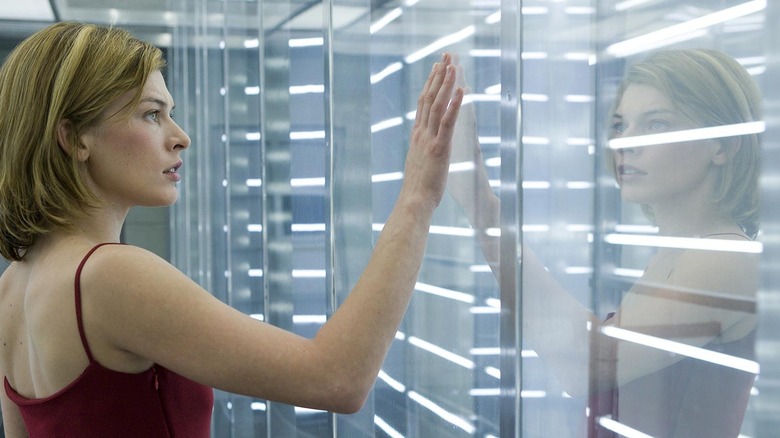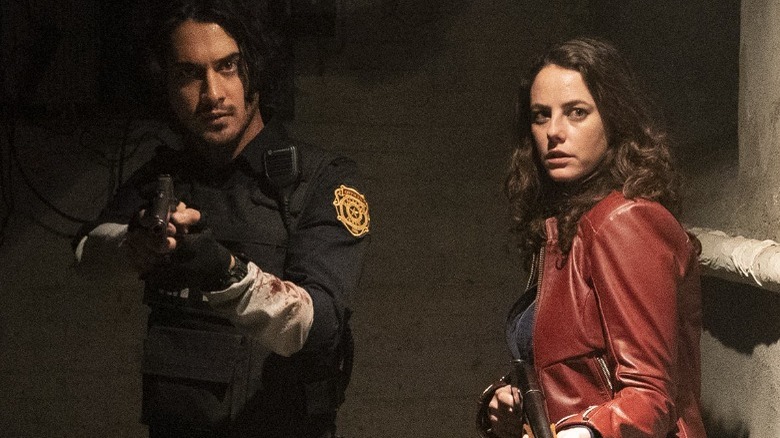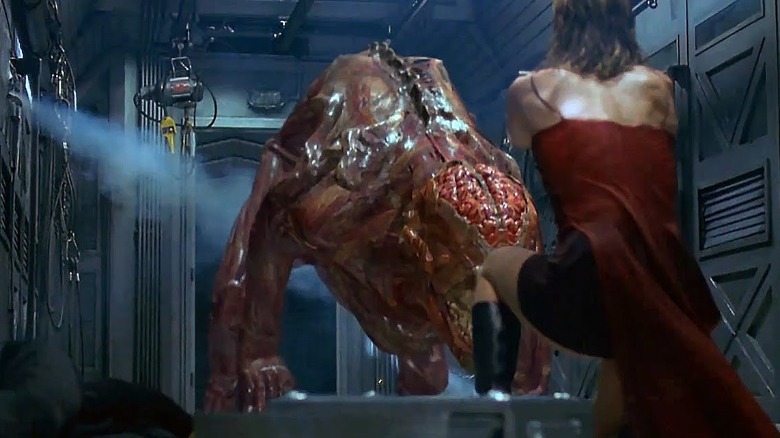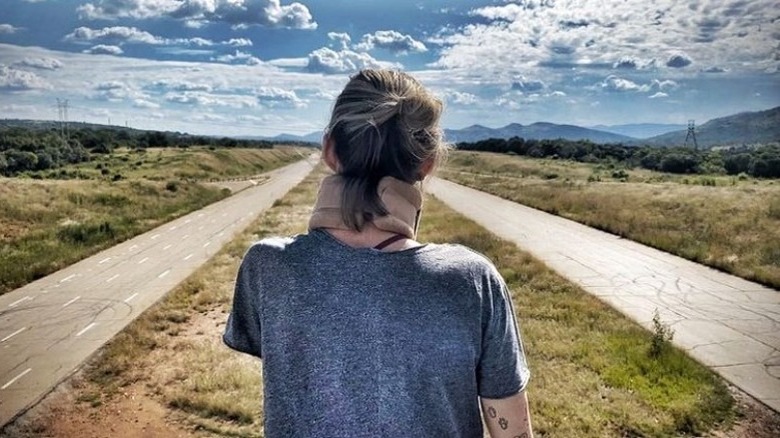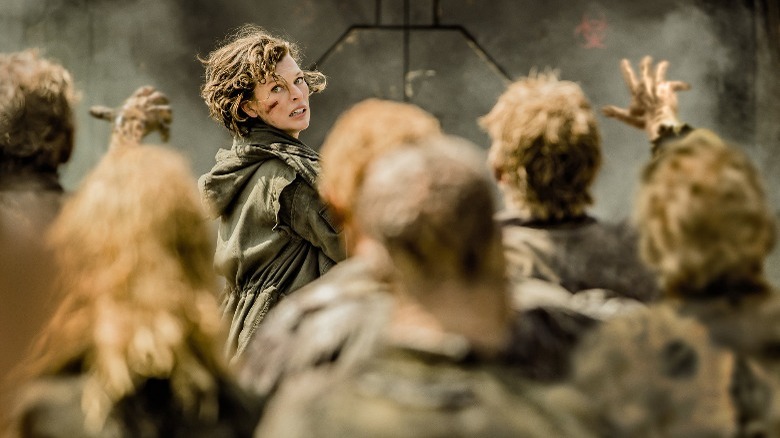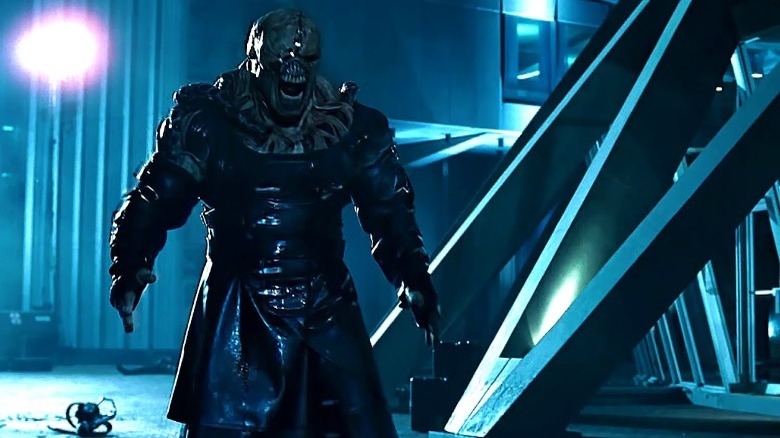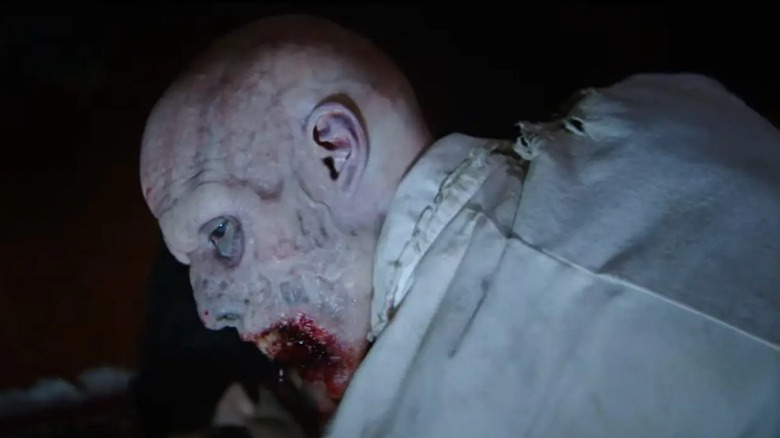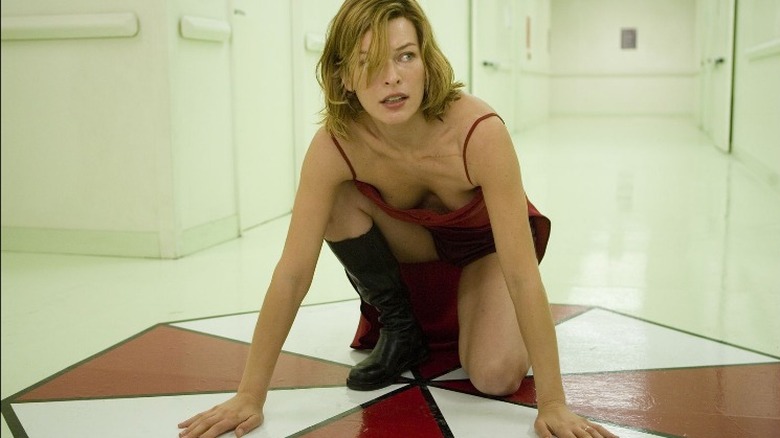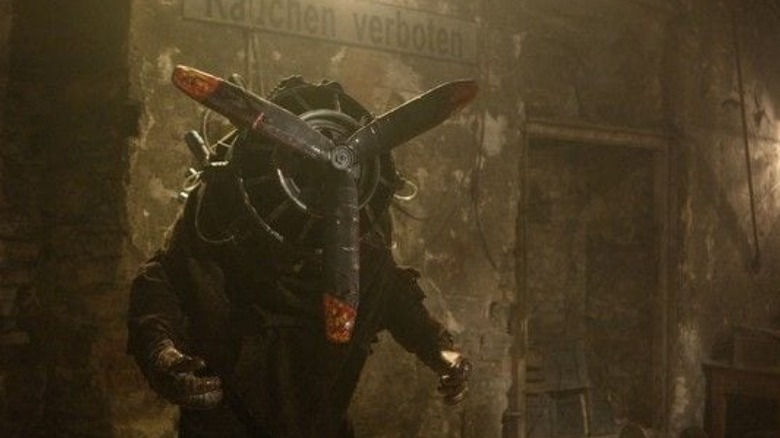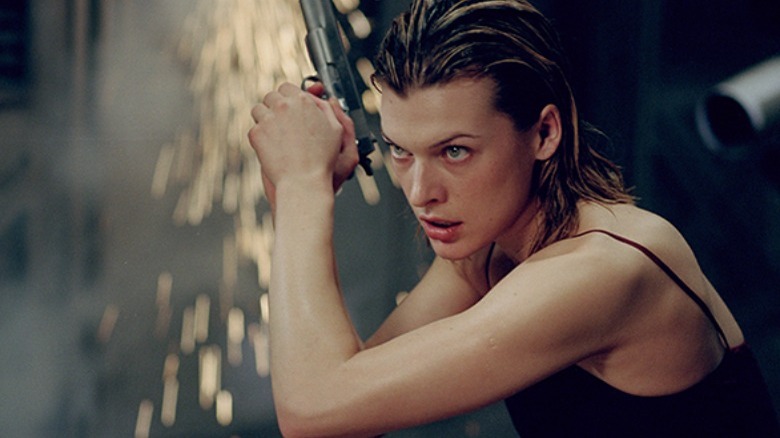The Most Controversial Moments In Resident Evil Movie History
Love or hate it, there's no denying the "Resident Evil" film franchise has been remarkably successful. Earning over $1.2 billion at the global box office, "Resident Evil" is one of horror's highest-grossing franchises. Narratively, "Resident Evil" is considerably removed from the video games that inspired it. But both mediums are spectacularly absurd.
The film series follows Milla Jovovich's Alice, a bio-weapon with a unique capacity to kill zombies. Throughout the original film series' six films, and not counting Johannes Roberts' "Welcome to Racoon City" reboot, Alice fights back against the Umbrella Corporation, a multinational conglomerate that dabbles in pharmaceuticals. Unfortunately, they also dabble in undead viruses, mutant bioweapons, and unleashing Hell on the citizens of Racoon City — dooming the world to succumb to zombies. Notably ridiculous and over-the-top, the series is admittedly a violent indulgence. While it's nothing like its source material, there's no denying Jovovich's enduring appeal as a superpowered zombie killer.
Yet, as successful as the franchise has been, it hasn't been without controversy. Here, we'll explore nine controversial moments in "Resident Evil" movie history.
Welcome to Raccoon City's casting
When director Johannes Roberts spoke to Fangoria about "Welcome to Raccoon City," he positioned it as a "faithful" adaptation. Rather than focusing on Alice's bioweapon antics, Roberts wanted his work to resemble the original "Resident Evil" video game and its aptly titled sequel, "Resident Evil 2." With dual storylines tracking incidents at the Raccoon City Police Department and the Spencer Mansion, Roberts distinctly captures the look of the games — and almost their tones too. While the "Resident Evil" reboot flopped at the box office, it's more like its source material than anything else in the franchise.
Still, "Welcome to Raccoon City" fumbled the ball when it came to casting – namely Kaya Scodelario as Claire Redfield, and Avan Jogia as Leon S. Kennedy. While Claire better resembles her video game counterpart, Jogia looks nothing like Kennedy. Additionally, Leon's characterization is at odds with the video games. Rather than being a stoic hero, Leon is akin to a bumbling fool — ambling about without any means of protecting himself. "Welcome to Raccoon City" is an inimitable guilty pleasure; but as is often the case, it encapsulates the difficulty in adapting beloved video games to the big screen.
Creating Alice for 2002's Resident Evil
"Resident Evil" wasn't a financial failure in any capacity. While critically panned, Paul W. S. Anderson's movie grossed over $100 million at the worldwide box office. After all, five additional entries followed, indicative of the movie's blockbuster success. Like Netflix's flopped "Resident Evil" series, the 2002 film failed to accurately adapt the innate appeal of Capcom's longstanding video game series.
Some contemporary fans defend "Resident Evil" – especially in light of what's come since. Chief among the film's problems is its conspicuous resistance to resembling the games. Anderson's story is entirely new, having no roots in the game's source material. Instead, he conceived Milla Jovovich's Alice for the movie. Also, the film's zombie action takes too long to arrive. When zombies eventually emerge, it lacks tension and urgency. In other words, the first adaptation of one of gaming's seminal horror properties failed to be scary. A guilty pleasure, sure, but the horror qualifier exists in name only.
Olivia Jackson's tragic accident
"Resident Evil: The Final Chapter" stuntwoman Olivia Jackson's life was forever changed by the injury she suffered on set. Sadly, the "Resident Evil" movie franchise's most controversial moment is also its bleakest. What happened was avoidable. To make it worse, disputes arose over whose responsibility it was to check stunts for safety. Jackson had been one of Jovovich's stunt doubles. According to court filings reviewed by Anousha Sakoui of The Los Angeles Times, Jackson was riding a motorcycle toward a camera attached to a mechanical crane. As Jackson raced toward it, the crane failed to lift. Jackson collided with the crane. She woke from a medically induced coma 17 days later. Jackson told the outlet, "I can't ever work again. I don't have the job that I was extremely successful in, and that I loved so much."
In 2020, Jackson won her legal battle against Bickers Actions SA's company for mishandling the stunt's set-up. However, it was a hollow victory. Jackson's financial recourse was limited under South African law where "The Final Chapter" was filmed. Although the film is fantasy, Jackson's endured trauma is a lifelong ordeal.
A history of on-set injuries
Rendering Olivia Jackson's accident more troubling is the continuous danger of "Resident Evil" film sets. Filmmakers and crew members need to ensure their film sets are safe. That is the bare minimum requirement for films: treat people as people and endeavor to secure their safety. When that doesn't happen, people are hurt, and lives are lost – like what tragically happened to cinematographer Halyna Hutchins on the set of "Rust."
The "Resident Evil" film series has a horrific legacy of on-set injuries, even resulting in the death of a crew member, per The Hollywood Reporter. Two months after Jackson's injury, Ricardo Cornelius died from injuries sustained on set. A car slid off a platform, pinning Cornelius and crushing his lungs. Another crew member suffered a plastic boulder-related injury. On the "Resident Evil: Retribution" set, 16 background actors were injured when a platform collapsed. Although the "Resident Evil" movies look great due to their stellar action and sensational stunt work, it's tragic that their success comes with a historic disregard for others' safety.
Nemesis in Resident Evil: Apocalypse
Nemesis is one of the "Resident Evil" franchise's most iconic monsters. Capcom's third video game entry, "Resident Evil 3: Nemesis," debuted the titular villain. Arguably, Nemesis is second only to the walking dead as one of the horror universe's key pieces of iconography. Fans were (naturally) thrilled when the press confirmed Nemesis would appear in Alexander Witt's "Resident Evil: Apocalypse."
Unfortunately, it's no different than the franchise's first film entry. "Apocalypse" is a lot of things, but it's not a faithful adaptation of its source material. Nemesis (Matthew G. Taylor) acts nothing like his video game counterpart. While his design works, his characterization is ludicrous. Framed as the film's antagonist, Nemesis concludes the film by teaming up with Alice in a last-minute twist that makes no sense. Movie fans contend the entry ruined Nemesis as a character, with some critics remarking Nemesis was "utterly ridiculous."
The Welcome to Raccoon City trailer
"Welcome to Raccoon City" isn't a bad movie — not by a long shot. Yes, it's formulaic and tonally inconsistent, but it was a worthwhile return to the world of "Resident Evil" and the Umbrella Corporation's perennial sins. Additionally, "Welcome to Raccoon City" was considerably stronger than its marketing material suggested, a welcome relief for fans who were (rightfully) incredulous when the first trailer dropped. Director Johannes Roberts recontextualized "Welcome to Raccoon City" as a horror movie first and foremost, exciting fans eager to see the film franchise showcase its horror roots.
Inexplicably, the "Welcome to Raccoon City" trailer unfolds as 4 Non Blondes' "What's Up?" plays. Fans were frustrated with the trailer's lack of focus and tonal inconsistency. Some remarked that the trailer was so bad that it might transcend to being good. While the final product delivered more genuine tension than the franchise's prior films, the trailer for "Welcome to Raccoon City" raised some alarm bells — looking more like a parody than the faithful adaptation promised to fans.
Sexualizing Alice
In 2009, frequent series director Paul W. S. Anderson married "Resident Evil" franchise star Milla Jovovich. While they weren't an item when filming 2002's "Resident Evil," the two started to date shortly after. Sure, it's all remarkably romantic. But at times, it leads viewers to wonder if their relationship blurred some directing lines. Maybe this accounts for some debatably regressive depictions of Alice. Throughout the film series, the camera hypersexualizes Alice – panning down her body. While it might be what the fans want, in retrospect, it doesn't render it any less uncomfortable.
Like many over-sexualized action heroines, Jovovich's Alice makes the most of her minimal wardrobe – short-shorts, dresses, and tight tops. Even Scarlett Johansson took umbrage with the overt-sexualization of her Black Widow role in the Marvel Cinematic Universe, another peg in the cinematic history of consigning female action leads to hyper-sexualization, whether it's integral to the character design or not.
Frankenstein's Army plagiarism allegations
Richard Raaphorst's "Frankenstein's Army" is an underrated horror gem, abounding with some of the most sensational creature designs in recent years. In the movie, a ragtag group of Soviet troops in Germany encounter an army of Victor Frankenstein's nightmarish creations. A B-movie with soul, "Frankenstein's Army" isn't just a fantastic horror outing: it's the kind of movie conceived of and filmed with a video game in mind. Raaphorst traps audiences in tight corridors, utilizing the found footage conceit to, as Matt Zoller Seitz of Roger Ebert remarked, "suggest a re-enactment of a halfway decent first-person shooter game."
Retrospectively, it's strange to contend that "Frankenstein's Army" is a more faithful "Resident Evil" movie than any of the ones titled "Resident Evil." As reported by Eurogamer, Raaphorst has accused Capcom of plagiarizing the design of one of his monsters for their release of the "Resident Evil: Village" game. (They look remarkably close.) While it's unclear whether there was any genuine copyright infringement at play, there's something incredulously amusing about a 2013 Dutch/United States co-production being better at adapting a "Resident Evil" villain than any of the actual franchise entries.
Ground Zero
To its credit, "Resident Evil" managed to dodge one controversy preemptively. While filming the franchise's first entry, "Resident Evil" had been titled "Resident Evil: Ground Zero" — a subtitle pointing toward the Umbrella Lab setting of the film as the origin of the T-virus (and all the subsequent death and destruction to follow). Due to the September 11 attacks, filming halted for a month (via 1428 Elm). Resultantly (and expectedly), the subtitle was dropped in favor of "Resident Evil."
At the time, this was a common move. Sam Raimi's "Spider-Man" pulled a teaser and poster from the release that prominently featured a reflection of the World Trade Center in Spider-Man's mask. "Zoolander" digitally removed the World Trade Center from its final cut. Even everyone's favorite incorrigible mouse, "Stuart Little," digitally removed references to the towers from its final cut. Here, "Resident Evil," perhaps for the first and only time, anticipated and adequately responded to a controversial moment.
